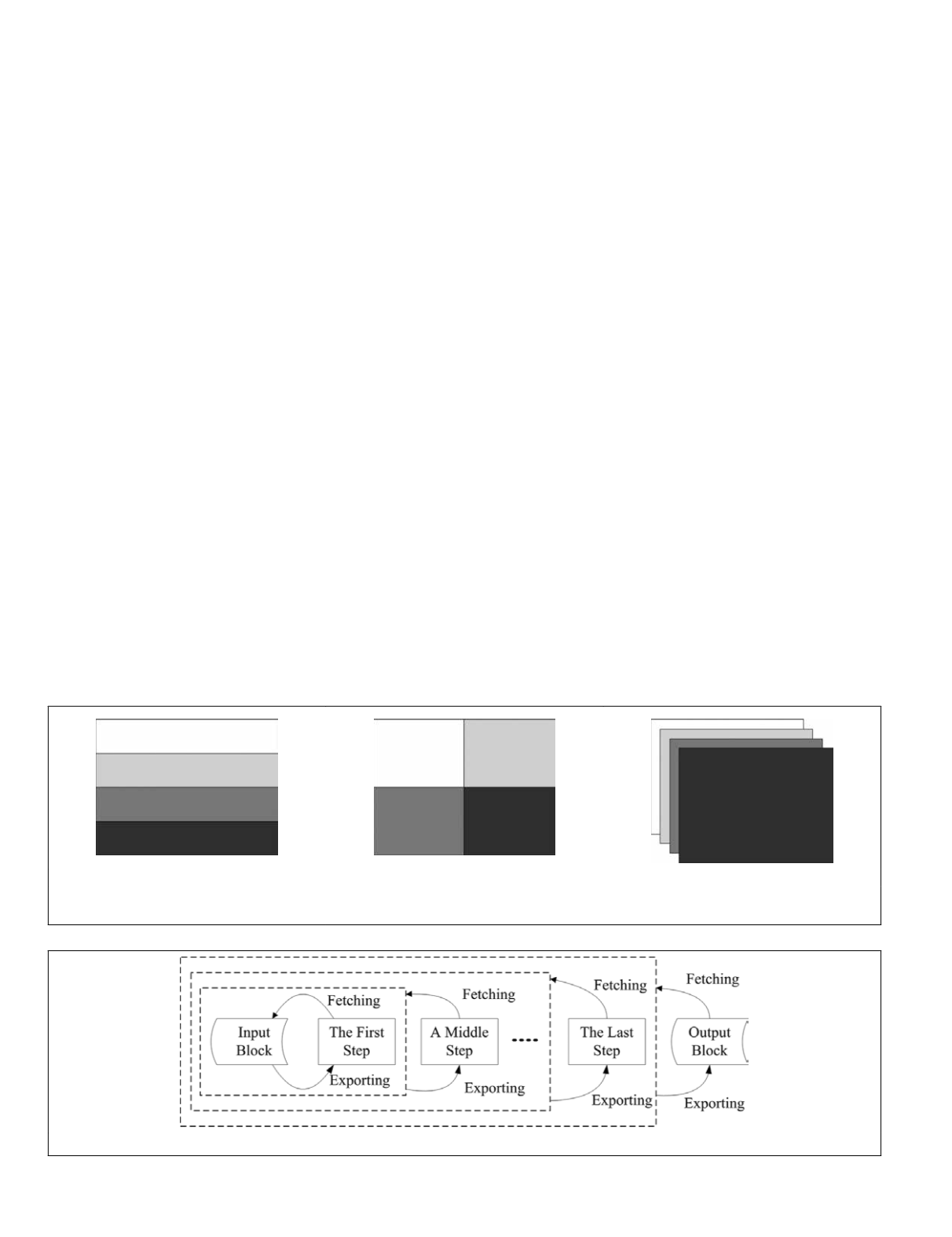
blocks one by one. The advantages of block partition rest on two
points. One is that a large task for a whole image is reduced to
many smaller pieces, which are processed by multiple
CPU
cores
simultaneously by parallel computing. The other aspect con-
cerns the temporal file. Because data volume corresponding to
a block is not large, the temporal processing results for a block
can be saved in the random-access memory (
RAM
) instead of in a
temporal file, although complicated calculations are required to
determine the results. Thus, a temporal file is not needed.
The strategies of block partition are shown in Figure 3. An
entire coverage in output bounds can be divided into strips
(Figure 3a), tiles (Figure 3b), or bands (Figure 3c). One of
these three strategies can be chosen according to the require-
ments. In practice, a tile is the form that is most commonly
used in data decomposition for parallel computing. In this
paper, the tested algorithms adopt different configurations of
block partition. De-correlation stretch employs two strate-
gies, i.e., tile (size: 64 × 64) and band based strategies, in its
different steps. The others adopt tile based strategy, but the
sizes of tiles are different: 64 × 64 for filtering, 128 × 128 for
DEM
extractions, and 512 × 128 for geometric correction, im-
age fusion, and image mosaics. The configurations of block
partition in this paper are based on the characteristics of each
algorithm, block size of file used to store final results, and
parallel performance achieved by us. These configurations
are relatively optimal selections. The rationale of choosing
partition strategy is worth discussing, but is out of the scope
of this paper.
A Recursive Procedure to Generate Final Results
If several steps are required to generate the final results,
the recursive procedure shown in Figure 4 for fetching and
processing data will be used, where each step is the same as
described in the following cases. The geometric correction,
which includes two steps, namely geometric transformation
and interpolating, is an example. The strategy is similar to
that described in the literature (Christophe
et al.
, 2011).
According to the characteristics of typical algorithms in
remote sensing based mapping, not only the intensity value
of the
(i, j)
pixel but also the global statistical information or
neighboring pixels of location
(i, j)
are used for location
(i, j)
in certain cases;
(i, j)
represents the pixel location. In general,
three cases exist in which the necessary data are required to
enable the entire processing of a block (Nicolescu and Jonker,
2002). The case in which only the corresponding pixels are
used and the case in which both the corresponding and neigh-
boring pixels are used are shown in Figure 5a and Figure
5b, respectively. For instance, the former includes geometric
transformation, and the latter includes interpolating, convo-
lution, etc. For the case in which the corresponding pixels
and the global statistical information are used, the global
information is generated at the beginning of a procedure. The
principal component analysis (
PCA
) projection and the de-
correlation stretch are examples where the global information
is the mean value, the standard deviation value for each band
and covariance matrix, etc.
The Parallel Processing Mechanism
Parallel processing is the concept of using multiple comput-
ers or
CPU
cores to reduce the time needed to solve a heavy
computational problem, operating on the principle that
large problems can often be divided into smaller ones and
then solved concurrently (Han
et al.
, 2009). In the course of
parallelization of a procedure, high parallelism is a primary
goal, which is usually evaluated by the index, i.e., speedup.
Because the final results of these tested algorithms can be
generated and saved in the form of blocks, the parallel com-
puting technique makes it possible for multiple blocks to be
processed concurrently on multiple
CPU
cores.
In this paper, the message passing interface (
MPI
) is used as
the parallel environment. The
MPI
is a message-passing appli-
cation-programmer interface packaged together with protocol
and semantic specifications for how its features must behave
in any implementation (Gropp
et al.
, 1996). The
MPI
features
high performance, scalability, and portability and is the most
common library used in high performance computing.
In a multi-core computer, one
CPU
core (or virtual core us-
ing hyper-threading technology widely used by an Intel
®
CPU
)
(a)
(b)
(c)
Figure 3. Three types of strategies of block partition: (a) Strip-based decomposition, (b) Tile-based decomposition, and (c) Band-based
decomposition.
Figure 4. The recursive procedure for fetching and exporting.
376
May 2015
PHOTOGRAMMETRIC ENGINEERING & REMOTE SENSING


